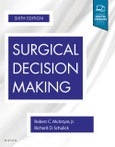Using a proven, practical, algorithmic approach, Surgical Decision Making summarizes evidence-based guidelines and practice protocols in an easy-to-follow format. Designed to sharpen the decision-making skills of both trainees and practicing surgeons, the 6th Edition directs your focus to the critical decision points in a wide range of clinical scenarios, helping you determine optimal evaluation and management to secure the best possible patient outcomes. Algorithms are accompanied by annotations that explain all critical factors affecting decisions in a concise, readable manner.
- Reflects the scope of practice of today's general surgeon, with fresh, expert perspectives from new editor Dr. Richard Schulick and numerous new contributors.
- Contains 58 new chapters and thoroughly revised content throughout.
- Includes new coverage of Preoperative Evaluation of the Geriatric Patient, Pancreatic Cystic Neoplasm, Familial Breast Cancer, Resuscitative Endovascular Balloon Occlusion of the Aorta, Blunt Cerebrovascular Injury, and much more.
- Uses an easy-to-follow, consistent format, with an algorithm on one page and short descriptions explaining the various steps in the decision-making process on the opposite page.
- Includes explanatory notes that summarize presenting signs and symptoms, laboratory investigation, diagnostic modalities, surgical therapies, and adjuvant therapies for each condition.
- Encompasses both general surgery and surgical subspecialties?helping you directly manage a broad range of problems.
- Emphasizes information that frequently appears on board exams.
- Enhanced eBook version included with purchase. Your enhanced eBook allows you to access all of the text, figures, and references from the book on a variety of devices.
Please Note: This is an On Demand product, delivery may take up to 11 working days after payment has been received.
Table of Contents
Part I - PERIOPERATIVE CARE 1. Preoperative Laboratory Evaluation 2. Preoperative Cardiac Evaluation 3. Preoperative Pulmonary Evaluation 4. Bleeding Disorders in Surgical Patients 5. Hypercoagulable Patient 6. Postoperative Fever 7. Bridge Anticoagulation 8. Intraabdominal Infection 9. Preoperative Evaluation of the Geriatric Patient
Part II - CRITICAL CARE 10. Cardiopulmonary Resuscitation 11. Perioperative Arrhythmia 12. Perioperative Myocardial Ischemia and Infarction 13. Shock 14. Goal-Directed Resuscitation 15. Pulmonary Embolism 16. Ventilator-Associated Pneumonia 17. Nutritional Support 18. Acute Respiratory Failure 19. Acute Hypoxic Event 20. Acute Renal Failure 21. Acid - Base Disorders 22. Sodium Disorders 23. Potassium Disorders 24. Calcium Disorders 25. Hypothermia
Part III - HEAD & NECK 26. Neck Mass 27. Nonmelanoma Skin Cancer of the Face 28. Management of Melanoma of the Head and Neck
Part IV - THORACIC 29. Lung Nodule 30. Mediastinal Tumors 31. Pleural Effusion and Empyema
Part V - ALIMENTARY TRACT 32. Achalasia 33. Esophageal Motility Disorders (Other Than Achalasia) 34. Esophageal Perforation 35. Caustic Ingestion 36. Gastroesophageal Reflux Disease 37. Barrett's Esophagus 38. Esophageal Diverticulum 39. Paraesophageal Hiatal Hernia 40. Gastric Ulcer 41. Duodenal Ulcer 42. Morbid Obesity 43. Upper GI Bleeding 44. Bleeding Esophageal Varices 45. Jaundice 46. Obstructive Jaundice: Interventional Options 47. Cholelithiasis 48. Choledocholithiasis 49. Hepatic Abscess 50. Cystic Liver Disease 51. Solid Liver Lesion 52. Acute Pancreatitis 53. Chronic Pancreatitis 54. Pancreatic Pseudocysts 55. Pancreas Divisum 56. Small Bowel Obstruction 57. Acute Mesenteric Vascular Occlusion 58. Short Bowel Syndrome 59. Enterocutaneous Fistula 60. Crohn's Disease of the Small Bowel 61. Right Lower Quadrant Pain 62. Volvulus 63. Diverticulitis 64. Lower Gastrointestinal Bleeding 65. Ulcerative Colitis 66. Ischemic Colitis 67. Toxic Megacolon 68. C. dif Colitis 69. Large Bowel Obstruction 70. Rectal Prolapse 71. Constipation 72. Appendicitis 73. Anorectal Abscess and Fistula-in-Ano 74. Hemorrhoids 75. Pilonidal Disease 76. Anal Fissure 77. Groin Hernia 78. Ventral Hernia
Part VI - ONCOLOGY 79. Cancer of Unknown Primary 80. Esophageal Cancer 81. Gastric Cancer 82. Cholangiocarcinoma 83. Hepatocellular Carcinoma 84. Gallbladder Carcinoma 85. Gastrointestinal Stromal Tumors (GISTs) 86. Pancreatic Neuroendocrine Tumor 87. Periampullary Carcinoma 88. Pancreatic Cystic Neoplasms 89. Pancreatic Mass 90. Retroperitoneal Mass 91. GI Lymphoma 92. Colon Polyp 93. Colon Cancer 94. Rectal Cancer 95. Anal Cancer 96 Metastatic Colorectal Carcinoma 97. Breast and Soft Tissues: Nipple Discharge 98. Gynecomastia 99. Palpable Breast Mass 100. Nonpalpable Breast Lesions 101. Early Breast Cancer 102. Advanced Breast Cancer 103. Recurrent Breast Carcinoma 104. Familial Breast Cancer 105. Breast Reconstruction 106. Soft Tissue Masses of the Extremities 107. Cutaneous Melanoma 108. Nonmelanoma Skin Cancer
Part VII - ENDOCRINE 1 109. Thyrotoxicosis 110. Thyroid Nodule 111. Well-Differentiated Thyroid Cancer 112. Medullary Thyroid Carcinoma 113. Hypercalcemia and Hyperparathyroidism 114. Hypoglycemia and Insulinoma 115. Zollinger-Ellison Syndrome 116. Adrenal Incidentaloma 117. Pheochromocytoma 118. Cushing's Syndrome 119. Primary Aldosteronism
Part VIII - TRAUMA 120. Initial Evaluation and Resuscitation 121. Airway Management 122. Cervical Spine Injury 123. Resuscitative Endovascular Balloon Occlusion of the Aorta (REBOA) 124. Emergency Department Thoracotomy 125. Penetrating Neck Trauma 126. Blunt Cerebrovascular Injury 127. Rib Fractures 128. Hemo-Pneumothorax 129. Blunt Thoracic Aortic Injury 130. Blunt Cardiac Injury 131. Annotations to Thoracoabdominal Trauma 132. Blunt Abdominal Trauma 133. Penetrating Abdominal Injury 134. Blunt Splenic Injury 135. Liver Injury 136. Abdominal Vascular Injuries 137. Pancreatic Injury 138. Duodenal Injury 139. Penetrating Injury of the Colon 140. Penetrating Rectal Injury 141. Damage-Control Laparotomy 142. Abdominal Compartment Syndrome 143. Traumatic Hematuria 144. Renal Injury 145. Ureteral Injuries 146. Bladder and Urethral Trauma 147. Pelvic Fractures 148. Closed Head Injury 149. Cervical Spine Fractures 150. Spinal Cord Injury 151. Popliteal Artery Injury 152. Burns 153. Acute Frostbite 154. Electrical Burn Injury








